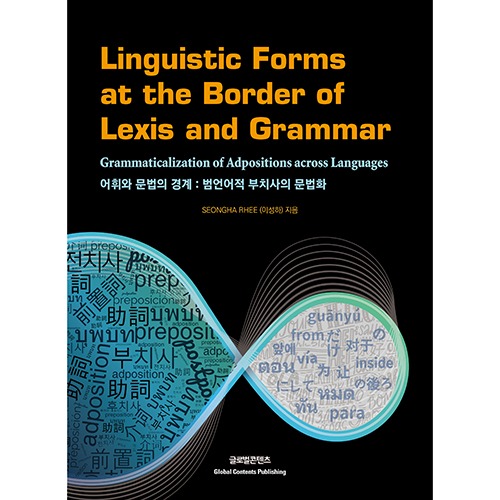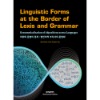 금주의 초특가 아수스 특별가 멀티 노트북 파격한정판매
금주의 초특가 아수스 특별가 멀티 노트북 파격한정판매
 무료배송 특별전 삼성노트북 파격전 사은품을 드립니다. 삼페인 무료증정
무료배송 특별전 삼성노트북 파격전 사은품을 드립니다. 삼페인 무료증정
 충격특별가전 테블릿 노트피씨 1+1 이벤트 사은품 증정
충격특별가전 테블릿 노트피씨 1+1 이벤트 사은품 증정
고객 상담 안내

은행 계좌
 상품상세
상품상세
 상품상세정보
상품상세정보
■책소개■
Linguistic Forms
at the Border of Lexis and Grammar
Prepositions and postpositions, collectively called adpositions, constitute an intriguing grammatical category in linguistics, primarily because of the universality of the patterns of their emergence and the wide range of functions they carry. They develop from syntactic structures involving nouns and verbs and become composite adpositions and further primary adpositions through grammaticalization. These patterns are nearly universally observed even in typologically diverse languages. This study is one of the first attempts to find commonalities and differences in the grammaticalization processes of adpositions in typologically and genealogically diverse languages, specifically: Korean, Japanese, English, Spanish, Chinese, and Thai, from quantitative and qualitative approaches. This study sheds light on the conceptual shifts and morphosyntactic changes of these linguistic forms which are on the border of lexis and grammar.
전치사와 후치사를 아우르는 부치사라는 범주는 언어학에서 매우 흥미로운 문법 범주이다. 이들의 발달 과정은 많은 언어에서 유사성을 띠며 그 기능에도 공통점이 많아 범언어적 비교 연구의 대상으로 적합하다. 부치사는 대개 명사와 동사를 포함하는 통사적 구조체에서 시작하여, 개념적・형태통사적으로 내적 응집력을 강화하면서 복합부치사로 발전한다. 이후 응집력이 더 강화된 합성부치사로 발전하고, 최종 단계에 이르면 개념적으로는 더 일반적이고 형태적으로는 더 간소화된 단순부치사가 된다. 이러한 발달 패턴은 많은 언어에서 공통적으로 발견되는 사항이다. 이 책은 계통적・유형론적으로 다양한 6개 언어, 즉 한국어, 일본어, 영어, 스페인어, 중국어, 태국어에서 부치사가 발달하는 과정을 말뭉치 자료와 문법화 이론을 가지고 분석한 드문 연구 중의 하나이다. 특히 이 연구는 어휘와 문법의 경계점에 놓여 있는 언어 형태들이 어떠한 개념적 전이와 형태통사적 변화를 겪어 문법 요소로 발전하는지를 잘 보여 준다.
 상품결제정보
상품결제정보
■지은이■
SEONGHA RHEE(이성하)
Seongha Rhee is Professor of Linguistics at Hankuk University of Foreign Studies, Korea. He received his Ph.D. in linguistics from the University of Texas at Austin in 1996. He served his university as the Vice-President of External Affairs (2012-2014), the International Circle of Korean Linguistics (president, 2019-2021), the Linguistic Society of Korea (president, 2013-2014), and the Discourse and Cognitive Linguistic Society of Korea (president, 2009-2011). He (co-)authored Understanding Grammaticalization (2016/1998, Hankook) and World Lexicon of Grammaticalization (2019, CUP). He has published book chapters in Grammaticalization Scenarios: Cross-linguistic Variation and Universal Tendencies (2020, Mouton), The Oxford Handbook of Grammaticalization (2011, OUP), and a few others; and has published a number of research articles in journals, including Nature, Journal of Pragmatics, Language Sciences, Lingua, and Journal of Historical Pragmatics. His primary research interest is to identify cognitive and discursive mechanisms that enable language change from the crosslinguistic and typological perspectives.
저자 이성하
미국 텍사스주립대학교에서 언어학 박사 학위를 취득했으며 현재 한국외국어대학교 영어학과 교수로 재직 중이다. 한국외국어대학교 대외부총장, 국제한국언어학회장, 한국언어학회장, 담화인지언어학회장, 스탠퍼드대학교 풀브라이트 교환교수 등을 역임하였다. Cambridge University Press, Oxford University Press, Mouton de Gruyter, John Benjamins, 한국문화사 등에서 저서 또는 북챕터를, Nature, Journal of Pragmatics, Language Sciences, Lingua, Journal of Historical Pragmatics등에 학술 논문을 출판하였다. 주로 언어 변화에 관여하는 인지적, 담화화용적 기제들을 범언어적, 유형론적 시각에서 연구하고 있다. (이메일: srhee@hufs.ac.kr 홈페이지: http://srhee.net)
 상품결제정보
상품결제정보
■목차■
Preface
Contents
List of Tables
List of Abbreviations
1. Introduction
1.1 Objectives
1.2 Research Methods
1.3 Language Typology and Language Samples
1.3.1 Korean
1.3.2 Japanese
1.3.3 English
1.3.4 Spanish
1.3.5 Chinese (Mandarin)
1.3.6 Thai
1.4 Grammaticalization
1.5 Scope of Research
2. Preliminaries: Space and Adposition
2.1 Space in Language
2.2 Adposition
2.2.1 Adposition as a Grammatical Category
2.2.2 Terminological Issues
2.2.3 Grammatical Functions of Adpositions
3. Grammaticalization of Postpositions in Korean
3.1 Introduction
3.2 Postpositions in Korean
3.3 Spatial Postpositions
3.3.1 Characteristics of Spatial Postpositions
3.3.2 Frequencies of Spatial Postpositions
3.3.3 Grammaticalization Sources
3.3.3.1 Nominal Sources
3.3.3.2 Verbal Sources
3.3.3.3 Deictic Sources
3.3.3.4 Multiple Sources and Layered Postpositions
3.4 Ongoing Grammaticalization of Spatial Postpositions
3.4.1 Selection Criteria
3.4.2 General Characteristics
3.4.3 Grammaticalization Mechanisms
3.4.3.1 Extension
3.4.3.2 Desemanticization
3.4.3.3 Decategorialization
3.4.3.4 Erosion
3.4.4 Grammatical Functions
3.4.4.1 Differential Specialization of Native Korean and Sino-Korean Postpositions
3.4.4.2 Functional Extension of Spatial Postpositions
3.5 Summary
4. Grammaticalization of Postpositions in Japanese
4.1 Introduction
4.2 Postpositions in Japanese
4.3 Spatial Postpositions
4.3.1 Characteristics of Spatial Postpositions
4.3.2 Frequencies of Spatial Postpositions
4.3.3. Grammaticalization Sources
4.3.3.1 Unidentified Sources
4.3.3.2 Nominal Sources
4.3.3.3 Verbal Sources
4.3.3.4 Sino-Japanese Sources
4.3.3.5 Multiple Sources and Layered Postpositions
4.4 Ongoing Grammaticalization of Spatial Postpositions
4.4.1 Selection Criteria
4.4.2 General Characteristics
4.4.3 Grammaticalization Mechanisms
4.4.3.1 Extension
4.4.3.2 Desemanticization
4.4.3.3 Decategorialization
4.4.3.4 Erosion
4.4.4 Grammatical Functions
4.5 Summary
5. Grammaticalization of Prepositions in English
5.1 Introduction
5.2 Prepositions in English
5.3 Spatial Prepositions
5.3.1 Characteristics of Spatial Prepositions
5.3.2 Frequencies of Spatial Prepositions
5.3.3 Grammaticalization Sources
5.3.3.1 Nominal Sources
5.3.3.2 Verbal Sources
5.3.3.3 Borrowings
5.3.3.4 Multiple Sources and Layered Prepositions
5.4 Ongoing Grammaticalization of Spatial Prepositions
5.4.1 Selection Criteria
5.4.2 General Characteristics
5.4.3 Grammaticalization Mechanisms
5.4.3.1 Extension
5.4.3.2 Desemanticization
5.4.3.3 Decategorialization
5.4.3.4 Erosion
5.4.4 Grammatical Functions
5.4.4.1 Beyond Space
5.4.4.2 Beyond Preposition
5.5 Summary
6. Grammaticalization of Prepositions in Spanish
6.1 Introduction
6.2 Prepositions in Spanish
6.3 Spatial Prepositions
6.3.1 Characteristics of Spatial Prepositions
6.3.2 Frequencies of Spatial Prepositions
6.3.3 Grammaticalization Sources
6.3.3.1 Inherited Prepositions
6.3.3.2 Nominal Sources
6.3.3.3 Verbal Sources
6.3.3.4 Adverbial Sources
6.3.3.5 Multiple Sources and Layered Prepositions
6.4 Ongoing Grammaticalization of Spatial Prepositions
6.4.1 Selection Criteria
6.4.2 General Characteristics
6.4.3 Grammaticalization Mechanisms
6.4.3.1 Extension
6.4.3.2 Desemanticization
6.4.3.3 Decategorialization
6.4.3.4 Erosion
6.4.4 Grammatical Functions
6.5 Summary
7. Grammaticalization of Adpositions in Chinese
7.1 Introduction
7.2 Adpositions in Chinese
7.3 Spatial Adpositions
7.3.1 Characteristics of Spatial Adpositions
7.3.2 Frequencies of Spatial Adpositions
7.3.3. Grammaticalization Sources
7.3.3.1 Nominal Sources
7.3.3.2 Verbal Sources
7.3.3.3 Other Sources
7.3.3.4 Multiple Sources and Layered Adpositions
7.4 Ongoing Grammaticalization of Spatial Adpositions
7.4.1 Selection Criteria
7.4.2 General Characteristics
7.4.3 Grammaticalization Mechanisms
7.4.3.1 Extension
7.4.3.2 Desemanticization
7.4.3.3 Decategorialization
7.4.3.4 Erosion
7.4.4 Grammatical Functions
7.4.4.1 Beyond Space
7.4.4.2 Beyond Prepositions and Postpositions
7.5 Summary
8. Grammaticalization of Prepositions in Thai
8.1 Introduction
8.2 Prepositions in Thai
8.3 Spatial Prepositions
8.3.1 Characteristics of Spatial prepositions
8.3.2 Frequencies of Spatial prepositions
8.3.3 Grammaticalization Sources
8.3.3.1 Nominal Sources
8.3.3.2 Verbal Sources
8.3.3.3 Other Sources
8.3.3.4 Multiple Sources and Layered Prepositions
8.4 Ongoing grammaticalization of Spatial Prepositions
8.4.1 Selection Criteria
8.4.2 General Characteristics
8.4.3 Grammaticalization Mechanisms
8.4.3.1 Extension
8.4.3.2 Desemanticization
8.4.3.3 Decategorialization
8.4.3.4 Erosion
8.4.4 Grammatical Functions
8.5 Summary
9. Grammaticalization Principles and Hypotheses Revisited
9.1 Divergence
9.2 Persistence
9.3 Source Determination
9.4 Unidirectionality
9.4.1 Form
9.4.2 Meaning
9.5 Universal Path
9.5.1 The Noun Channel
9.5.2 The Verb Channel
9.6 Analogy, Reanalysis, and Reinterpretation
9.7 Summary
10. Typology and Beyond
10.1 Commonalities
10.1.1 Restrictive Determinants and Expansive Motivations
10.1.2 Propensity for Positivity
10.2 Word order
10.3 Inflection vs. Agglutination vs. Isolation
10.4 Language Contact
10.5 Summary
11. Conclusion
Appendix 1. Korean Complex Postpositions
Appendix 2: English Complex Prepositions
Appendix 3: Composite and Complex Prepositions in Spanish
Bibliography
Author Index
Subject index

 메인으로
메인으로 이용안내
이용안내 장바구니
장바구니 주문조회
주문조회 마이페이지
마이페이지 질문과답변
질문과답변 즐겨찾기 추가하기
즐겨찾기 추가하기 상품 분류 카테고리 리스트
상품 분류 카테고리 리스트




































 상품 사용 후기
상품 사용 후기


 상품 Q&A
상품 Q&A




